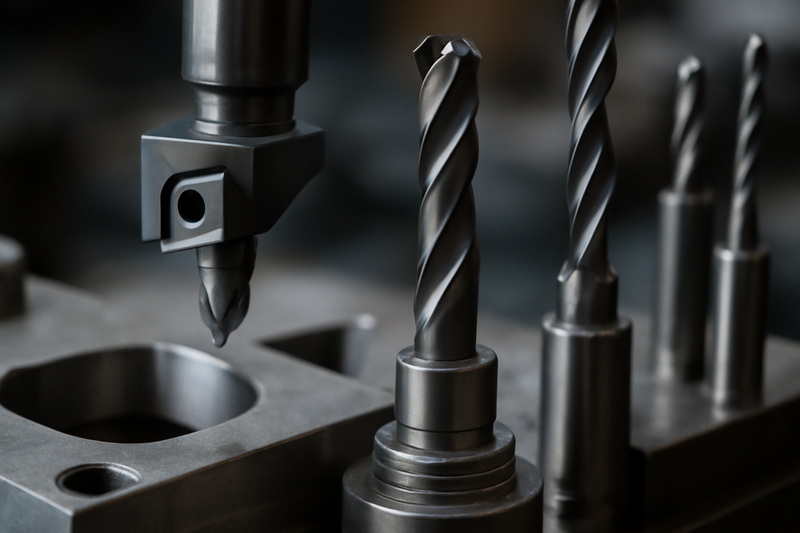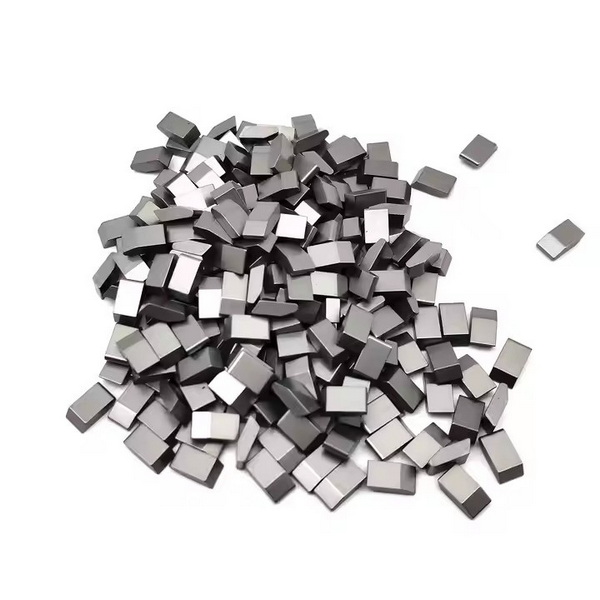Content Menu
● Introduction to Tungsten Carbide
>> Physical Properties
● Understanding the Melting Point of Tungsten Carbide
>> Exact Melting Temperature
>> Comparison with Related Materials
>> Melting Behavior and Binder Effects
● Crystal Structure and Bonding in Tungsten Carbide
>> Covalent and Metallic Bonding
● Thermal and Mechanical Properties Relevant to Melting
>> Thermal Stability
>> Hardness and Strength
● Advanced Manufacturing Techniques
>> Hot Isostatic Pressing (HIP)
>> Spark Plasma Sintering (SPS)
● Manufacturing and Processing of Tungsten Carbide
>> Powder Preparation and Sintering
>> Grain Size Impact
● Environmental and Safety Considerations
>> Toxicity and Handling
>> Recycling and Sustainability
● Expanded Industrial Applications
>> Mining and Drilling
>> Aerospace Components
>> Medical Instruments
>> Jewelry and Fashion
>> Electronics and Electrical Contacts
● Recent Research and Developments
>> Nanocomposites
>> Coating Technologies
>> Additive Manufacturing
● Practical Considerations When Using Tungsten Carbide
>> Handling and Storage
>> Machining and Sharpening
>> Cost Factors
● Conclusion
● Frequently Asked Questions (FAQ)
>> 1. What is the exact melting point of tungsten carbide?
>> 2. How does tungsten carbide compare to pure tungsten in terms of melting point?
>> 3. Why is cobalt used as a binder in tungsten carbide composites?
>> 4. Can tungsten carbide oxidize at high temperatures?
>> 5. What industries benefit most from tungsten carbide's high melting point?
Tungsten carbide is a remarkable material widely used in various industrial applications due to its exceptional hardness, wear resistance, and thermal stability. Understanding its melting temperature is crucial for industries that rely on tungsten carbide for cutting tools, wear-resistant coatings, and high-temperature components. This comprehensive article explores the melting point of tungsten carbide, its physical and chemical properties, manufacturing processes, applications, recent developments, environmental considerations, and answers frequently asked questions related to this extraordinary material.

Introduction to Tungsten Carbide
Tungsten carbide is a chemical compound composed of tungsten and carbon atoms, typically in a 1:1 ratio, forming a dense hexagonal crystal structure. It combines the hardness of ceramic materials with the toughness of metals when bonded with metallic binders such as cobalt or nickel. This combination results in a material that is extremely hard, durable, and capable of withstanding harsh environments.
Physical Properties
- Melting Point: Approximately 2,870°C (5,198°F)
- Boiling Point: Around 6,000°C (10,830°F)
- Density: About 15.5 to 15.7 g/cm³
- Mohs Hardness: 9 to 9.5 (second only to diamond)
- Young's Modulus: Between 530 and 700 GPa
- Thermal Conductivity: Approximately 85 to 110 W/(m·K)
- Thermal Expansion Coefficient: Around 5.4 to 5.8 µm/m·K
These properties make tungsten carbide ideal for applications requiring high wear resistance, strength at elevated temperatures, and dimensional stability.
Understanding the Melting Point of Tungsten Carbide
Exact Melting Temperature
Tungsten carbide melts at about 2,870°C (5,198°F). This melting point is significantly higher than most metals and many other carbides, making it suitable for high-temperature applications. The high melting temperature is due to the strong covalent bonding between tungsten and carbon atoms in the crystal lattice.
Comparison with Related Materials
| Material | Melting Point (°C) | Notes |
| Tungsten (metal) | 3,422 | Highest melting point of any metal |
| Tungsten Carbide (WC) | ~2,870 | High melting point, extremely hard |
| Cemented Carbide | 1,400 - 1,500 | Composite of tungsten carbide and cobalt |
| Tantalum Hafnium Carbide | 4,215 | One of the highest melting points known |
While tungsten metal melts at an even higher temperature, tungsten carbide's melting point is still remarkably high, enabling it to maintain structural integrity under extreme heat.
Melting Behavior and Binder Effects
In industrial use, tungsten carbide is often combined with metallic binders like cobalt or nickel to form cemented carbides. These binders melt at much lower temperatures (around 1,400–1,500°C), which allows the composite to be sintered and shaped without melting the tungsten carbide itself. This process is essential for manufacturing cutting tools and wear-resistant parts.
Crystal Structure and Bonding in Tungsten Carbide
Tungsten carbide's unique properties stem from its crystal structure and the nature of the bonding between tungsten and carbon atoms. The compound crystallizes in a hexagonal close-packed structure, where each tungsten atom is surrounded by carbon atoms in a tightly bonded lattice. This strong covalent bonding contributes to its exceptional hardness and high melting point. The electron sharing between tungsten and carbon atoms creates a robust lattice that resists deformation and thermal breakdown.
Covalent and Metallic Bonding
While tungsten carbide is primarily covalently bonded, the presence of metallic bonding due to tungsten atoms adds toughness to the material. This dual bonding nature allows tungsten carbide to combine the hardness of ceramics with the toughness of metals, making it suitable for demanding industrial applications.
Thermal and Mechanical Properties Relevant to Melting
Thermal Stability
Tungsten carbide maintains its hardness and strength at elevated temperatures, making it ideal for cutting tools used in high-speed machining. However, oxidation can begin at around 500–600°C in oxygen-rich environments, which can degrade the material over time if not protected.
Hardness and Strength
- Mohs Hardness: 9 to 9.5
- Vickers Hardness: Approximately 2,600 HV
- Ultimate Tensile Strength: Around 350 MPa
- Compressive Strength: Up to 6,000 MPa
These mechanical properties ensure tungsten carbide can withstand high mechanical stresses without deformation, even near its melting point.
Advanced Manufacturing Techniques
Beyond traditional powder metallurgy and sintering, advanced manufacturing techniques have been developed to enhance the properties of tungsten carbide components. Techniques such as hot isostatic pressing (HIP) and spark plasma sintering (SPS) allow for finer grain sizes and improved density, resulting in superior mechanical properties.
Hot Isostatic Pressing (HIP)
HIP involves applying high pressure and temperature simultaneously to the tungsten carbide powder compact, reducing porosity and increasing strength. This process improves the uniformity of the material and enhances its wear resistance.
Spark Plasma Sintering (SPS)
SPS uses pulsed electric currents to rapidly heat the powder compact, enabling sintering at lower temperatures and shorter times. This technique preserves fine grain sizes and reduces grain growth, which is critical for maintaining hardness and toughness.
Manufacturing and Processing of Tungsten Carbide
Powder Preparation and Sintering
Tungsten carbide is produced by combining tungsten metal powder with carbon (usually graphite) and then heating the mixture in a high-temperature furnace (1,300–1,600°C) in a process called carburization. The resulting powder is then mixed with a metallic binder and compacted into shapes before sintering at temperatures around 1,400–1,500°C. This process produces a dense, hard material without melting the tungsten carbide itself.
Grain Size Impact
The size of tungsten carbide grains significantly affects the material's hardness and melting behavior. Smaller grains result in higher hardness and better mechanical properties. Controlling grain size through heat treatment and powder processing is critical for producing high-quality tungsten carbide components.
Environmental and Safety Considerations
Working with tungsten carbide requires attention to environmental and safety factors. The dust generated during grinding or machining can be hazardous if inhaled, necessitating proper ventilation and protective equipment.
Toxicity and Handling
Tungsten carbide itself is considered relatively inert, but cobalt binders used in composites can pose health risks. Prolonged exposure to cobalt dust or fumes may cause respiratory issues and skin sensitization. Therefore, workplaces must implement strict safety protocols.
Recycling and Sustainability
Due to the high cost and environmental impact of tungsten mining, recycling tungsten carbide scrap is common. Recycling processes recover tungsten and cobalt for reuse, reducing waste and conserving resources.
Expanded Industrial Applications
Mining and Drilling
Tungsten carbide is extensively used in mining and drilling equipment, such as drill bits and cutting tools, due to its ability to withstand abrasive conditions and high temperatures. For example, tungsten carbide-tipped drill bits are standard in oil and gas exploration.
Aerospace Components
In aerospace, tungsten carbide components are used in turbine blades and engine parts that require high-temperature resistance and wear durability. The material's stability at elevated temperatures ensures reliable performance in harsh environments.
Medical Instruments
Tungsten carbide's biocompatibility and hardness make it ideal for surgical instruments and dental tools. Its wear resistance ensures longevity and precision in medical applications.
Jewelry and Fashion
Tungsten carbide is also popular in the jewelry industry for making rings and watches. Its scratch resistance and durability make it a preferred choice for everyday wear items that maintain their appearance over time.
Electronics and Electrical Contacts
Due to its excellent conductivity and resistance to wear, tungsten carbide is used in electrical contacts and electrodes, where durability and consistent performance are critical.

Recent Research and Developments
Research continues to improve tungsten carbide's properties and expand its applications. Nanostructured tungsten carbide composites are being developed to enhance toughness and reduce brittleness. Additionally, coatings combining tungsten carbide with other materials aim to improve corrosion resistance.
Nanocomposites
Nanocomposites incorporate nanoparticles into the tungsten carbide matrix, refining grain size and improving mechanical properties. These materials show promise for cutting tools with longer lifespans and better performance.
Coating Technologies
Innovative coating methods, such as chemical vapor deposition (CVD) and physical vapor deposition (PVD), are used to apply thin tungsten carbide layers on substrates, enhancing surface hardness and wear resistance without adding bulk.
Additive Manufacturing
Emerging additive manufacturing (3D printing) techniques are being explored to produce complex tungsten carbide parts with tailored properties. These methods may reduce waste and enable rapid prototyping of custom components.
Practical Considerations When Using Tungsten Carbide
Handling and Storage
Tungsten carbide parts should be handled carefully to avoid chipping or cracking. Although extremely hard, the material can be brittle under impact. Proper storage in cushioned containers helps maintain component integrity.
Machining and Sharpening
Machining tungsten carbide requires specialized tools and techniques, often involving diamond grinding wheels. Maintaining sharpness and surface finish is critical for tool performance and longevity.
Cost Factors
Tungsten carbide is more expensive than many metals due to raw material costs and complex manufacturing processes. However, its durability often results in lower total cost of ownership in industrial applications.
Conclusion
Tungsten carbide's melting point of approximately 2,870°C places it among the most heat-resistant materials used in industry. Its combination of high hardness, thermal stability, and wear resistance makes it indispensable for cutting tools, wear coatings, and high-temperature applications. The ability to manufacture tungsten carbide with controlled grain size and binder content allows for tailored properties to meet specific industrial needs. Despite its exceptional properties, tungsten carbide requires careful handling at high temperatures to avoid oxidation and binder degradation. Ongoing research into nanocomposites, coatings, and additive manufacturing promises to further enhance the versatility and performance of tungsten carbide. Overall, tungsten carbide remains a cornerstone material in modern manufacturing and engineering, enabling advancements in technology and industrial efficiency.

Frequently Asked Questions (FAQ)
1. What is the exact melting point of tungsten carbide?
The melting point of tungsten carbide is approximately 2,870°C (5,198°F), which is significantly higher than many other metals and carbides.
2. How does tungsten carbide compare to pure tungsten in terms of melting point?
Pure tungsten melts at a higher temperature of about 3,422°C (6,192°F), while tungsten carbide melts at around 2,870°C. However, tungsten carbide offers greater hardness and wear resistance.
3. Why is cobalt used as a binder in tungsten carbide composites?
Cobalt has excellent wettability with tungsten carbide and melts at a lower temperature (around 1,400–1,500°C), allowing the composite to be sintered and shaped without melting the tungsten carbide grains.
4. Can tungsten carbide oxidize at high temperatures?
Yes, tungsten carbide begins to oxidize at temperatures of about 500–600°C in oxygen-rich environments, which can degrade the material if not protected.
5. What industries benefit most from tungsten carbide's high melting point?
Industries such as manufacturing (cutting tools), mining, aerospace, oil and gas, and electronics rely on tungsten carbide for its high melting point, hardness, and wear resistance.
















